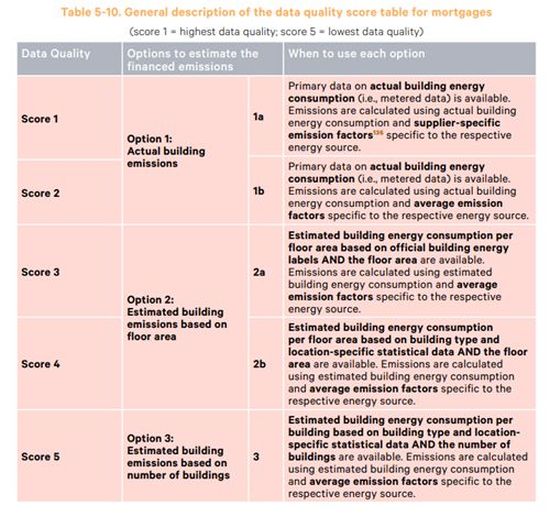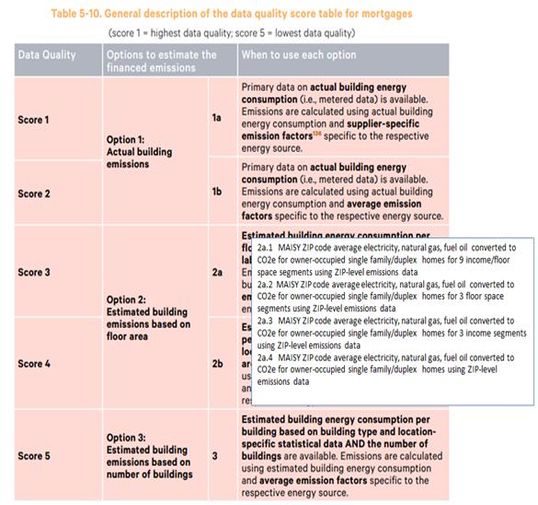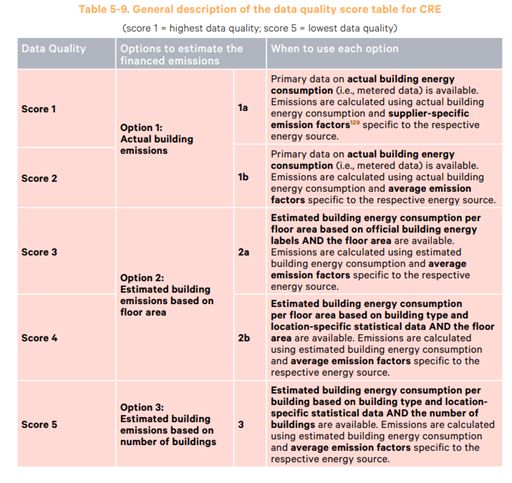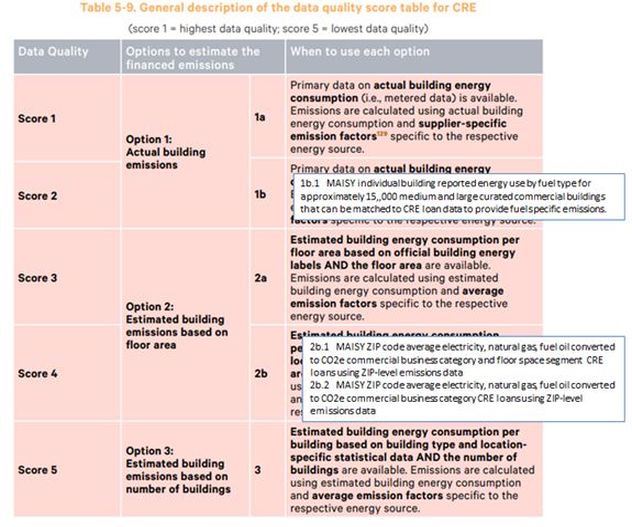MAISY Scope 3 Financed Emissions Data Accuracy
A Summary of MAISY Scope 3 Financed Emissions Accuracy
Aligning MAISY Scope 3 financed Emissions Data to PCAF Data Quality ClassesRegulatory agencies suggests using the PCAF methodology and data accuracy assessment protocol to compute financial company mortgage and commercial real estate (CRE) customer emissions.Quoting the rule: "The Partnership for Carbon Accounting Financials’ Global GHG Accounting & Reporting Standard (the “PCAF Standard” ) provides one methodology that complements the GHG Protocol and assists financial institutions in calculating their financed emissions. The PCAF Standard was developed to work with the calculation of Scope 3 emissions for the “investment” category of downstream emissions and was endorsed by the drafters of the GHG Protocol." The PCAF standard identifies and ranks data quality for alternative emissions estimation approaches for both residential mortgages and CRE loans. The PCAF standard states that “financial institutions shall use the highest quality data available for each asset class and improve the quality of the data over time.” A brief summary of MAISY data accuracy alignment with PCAF standards is provided below for mortgages and CRE loan customers. Summary of MAISY US Mortgage Emissions Calculations The PCAF graphic below identifies various levels of mortgage emissions data quality. The graphic and suggestions are meant to be instructional and not a rigid ranking. Option 1 methods, the most accurate method uses actual mortgagor emissions data or actual energy consumption data and location-specific emissions conversion data to convert to CO2e. US financial institutions do not currently have access to this information. Option 2 methods suggest incorporating dwelling unit detail such as floor space to improve estimation accuracy. Option 3, the least accurate, uses only the number of dwelling units and an average energy use per dwelling unit. 
The conceptual ranking above leaves out many data inputs that can contribute to more accurate emissions estimates. For example, including ZIP code detail in the emissions estimation process can change emissions estimate results by orders of magnitude because of variations in energy use associated with ZIP level differences in income, dwelling unit size and fuels used for space heating, water heating, clothes drying, cooking and more. MAISY mortgage emissions data fit neatly right below Option 1 and include four options ranging from the most accurate (2a.1) to less accurate (2a.4). 
MAISY Option 2a.4 provides an estimate of ZIP average electricity kwh, fuel oil and natural gas BTUs and emissions for owner-occupied single family and duplex dwelling units using only mortgage customer‘s ZIP codes. MAISY Option 2a.3 provides averages for ZIP average electricity kwh, fuel oil and natural gas BTUs and emissions for owner-occupied single family and duplex dwelling units for three income segments. MAISY Option 2a.2 provides averages for ZIP average electricity kwh, fuel oil and natural gas BTUs and emissions for owner-occupied single family and duplex dwelling units for three floor space segments. MAISY Option 2a.1, the most accurate, provides ZIP average electricity kwh, fuel oil and natural gas BTUs and emissions for owner-occupied single family and duplex dwelling units for nine income/floor space segments. EPA EGRID subregion and Department of Energy state fuel-specific emissions are applied to convert from energy source to CO2e emissions in each ZIP code. MAISY ZIP level data are sourced from various US Department of Energy, Department of Commerce, state agencies and individual electric utilities providing maximum transparency and audit requirements. Summary of MAISY US Commercial Real Estate (CRE) Loan Emissions Estimates The PCAF graphic below identifies various levels of CRE loan emissions data quality. Ranking of data quality is similar to that of residential mortgage emissions ranging from actual emissions reporting to the least accurate application of number of buildings and average energy use per building applied to average emissions factors. 
The MAISY Scope 3 CRE Database includes curated energy use reported by more than 15,000 medium to large commercial buildings that can be matched to financial firm addresses to provide option 1b data quality for certain geographic locations (identified in the graphic below as 1b.1). MAISY ZIP-level Scope 3 CRE Database provides average energy use and emissions data for detailed building/floor space categories in each ZIP code. MAISY 2b.2 Applies number of buildings in each building category in each ZIP code to building-specific average electricity kWh, fuel oil and natural gas use in that ZIP and emissions factor for that ZIP code. MAISY 2b.1 Applies number of buildings in each building/floor space category in each ZIP to building/floor space segment average electricity kWh, fuel oil and natural gas use in that ZIP and emissions factor for that ZIP code. The graphic below reflects MAISY CRE loan emissions resources and their alignment with the conceptual PCAF ranking. 
EPA EGRID subregion and Department of Energy state fuel-specific emissions are applied to convert from energy source to CO2e emissions. Estimates of CRE ZIP level energy use are based on a census of commercial businesses in each ZIP area and additional data sourced from various US Department of Energy, Department of Commerce, state agencies and individual electric utilities providing maximum transparency and audit requirements. ZIP Detail is Key to Accurate Portfolio Represenations MAISY Scope 3 Financed Emissions Databases provide superior estimates of financial firm residential mortgage and CRE loan portfolio emissions by providing ZIP-level customer energy use and emissions data that are then matched to each financial firm's customers ZIP code. For residential mortgage customers, additional accuracy is available where residential mortgage customer data includes either income or floor space (or both). For CRE loan customers, a general business category code is strongly preferred (though not required). Additional accuracy is available where individual CRE customer data includes floor space. See the Notes and Whitepapers Section for a note that illustrates the advantage of MAISY ZIP-level energy use data compared to state averages.
|
